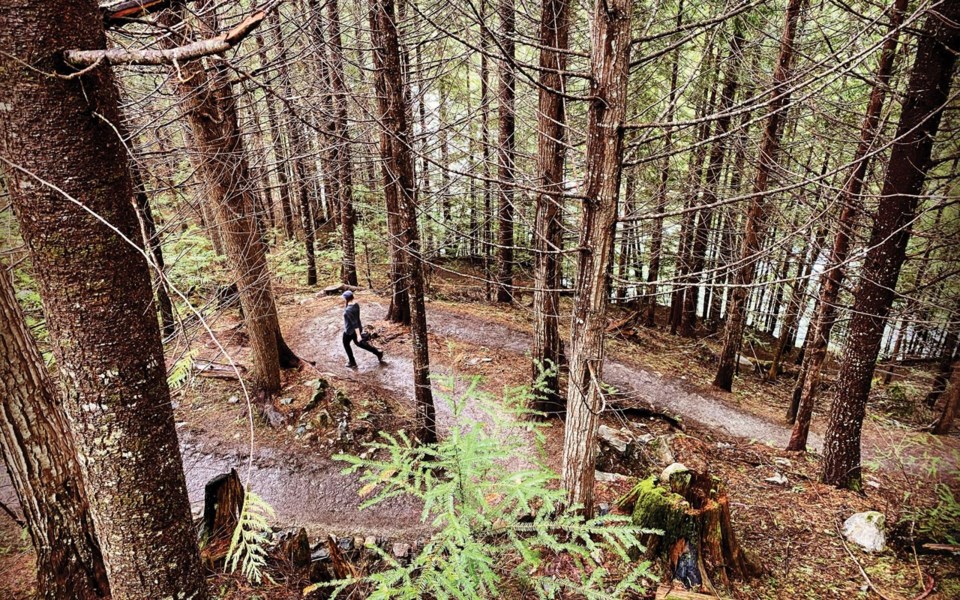When the pandemic shutdown hit in March, like many Whistler folks, my partner and I started a daily walk routine as a way to escape the house and get some exercise. For a week or so, our forays were confined to our Creekside neighbourhood, a combination of Valley Trail and street walking on a loop I often ran in the summer.
Of course, the lakes all remained frozen, slick patches lurked on the Valley Trail, and it was still snowing occasionally. It felt a bit more like winter than spring and so, on a few sunny days when we knew the snow would soften sufficiently we ski-toured up Whistler from Creekside base, starting on the route Whistler Blackcomb had flagged for that purpose—up Lower Dave Murray, crossing over to Peak to Creek, and from there upwards through Kadenwood and beyond. The skiing was fantastic, those excursions some of the best days spent during the early pandemic.
They were also revealing: there were all sorts of interconnecting trails and old logging roadways to explore while making our way upwards on skis. Furthermore, without humans around, the number of animal tracks revealed in the snow were legion, crisscrossing the runs everywhere—bear, bobcat, cougar, ermine, rabbit, and numerous small rodents. It was a bit of a window into who we actually share this valley with—a roll call that would continue after we were booted from the mountain when it was shuttered for good before Easter weekend.
By this point, the Valley Trail had become disturbingly busy, swarmed with people who weren't practicing proper physical distancing, and so we had long-since moved our daily walks over to the Whistler Golf Club course, on which trails had been cleared around the entirety. Here, you could walk a loop from one end to another on snow-and-ice-covered asphalt tracks used by summer golfers, with hip-high snow all around you. With winter still raging on the mountains through April, it was the month or so spent wandering the golf course that really provided a window into how the valley rolls into spring. It started with migratory waterfowl that showed up as soon as there was any water freed from ice. There were Canada geese, of course, whose large males would, later in the season, stand on the path and aggressively challenge you; on the duck ledger, there were the usual mallards and teals and pintails, but also Gadwall, Wood duck, Buffleheads and others that we never quite determined species for. They were just passing through and there would be a new lot every few days, like a shift change.
As the snow melted and bare patches were revealed, a curious phenomenon occurred: robins came out of the woodwork. Hundreds and hundreds of them, hunting together through the grass shoots, then flying up like a flock into the low branches of trees as you passed. Soon, the crows and ravens arrived and things got a whole lot noisier. While this was happening, we also began to notice deer tracks here and there. This was interesting because deer are almost phantoms in the valley, and yet here they were, surrounded on all sides by neighbourhoods. Then, out of this same urban patchwork, the bears appeared, one by one, day by day, to mow through new grass shoots on their favourite patch of course. Whether grazing or snoozing on daybeds, they paid absolutely zero attention to us as we strolled by. There was also a unique human dimension: over the course of a few weeks we watched a crew clear all the greens off with snowblowers to allow the grass to rejuvenate, something I never even knew occurred on golf courses but which proved remarkably effective as these areas greened up immediately and any new snow that fell on them melted instantly. Eventually, with so much preparation work going on—as well the dicey combination of numerous bears and the usual inconsiderate people with off-leash dogs—the course was shut to walkers and we moved on.
Now we began exploring farther and wider, crossing the valley to walk or run along the West Side Road and discovering myriad trails we previously didn't know existed. It provided for lots of fun exploration, wading up from the road through isothermic snow patches onto newly revealed dirt. By this point, I already felt like I'd learned more about the real Whistler in six weeks than I had in the 20 years I'd lived here. But the biggest find of all would come closer to home.
Having regularly walked from our house down to the valley, we began climbing up the streets above it. I knew there was at least one way onto the mountain there because many moons ago I'd managed to ski down to these streets and walk home, but what was revealed here over the course of a few weeks was a literal phantasmagoria of tracks and trails connecting all the neighbourhoods on the lower part of Whistler Mountain; some were marked recreational trails, others more dedicated bike routes, and many just abandoned logging roadbeds used mostly by bears to either skirt human developments or find their way into and out of trouble. But now we knew how to connect those dots as well.
The valley had woken up—and so had we.
Leslie Anthony is a Whistler-based author, editor, biologist and bon vivant who has never met a mountain he didn't like.




